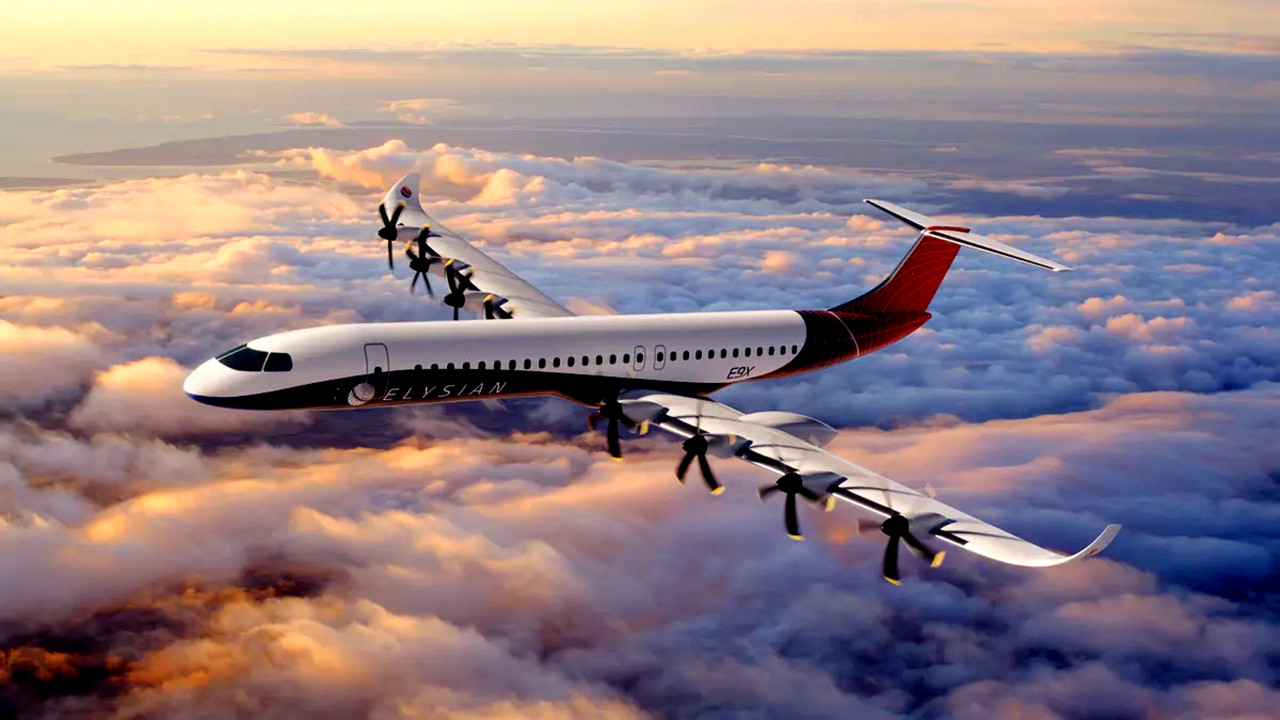Electric 90-passenger plane could fly 500 miles
Writer: | Editor: Lin Qiuying | From: Shenzhen Daily | Updated: 2024-08-13
Commercial aviation is struggling to reduce its climate impact and it’s currently not on track to meet its goal of net-zero emissions by 2050. Sustainable aviation fuel is not being produced fast enough and there seem to be few alternatives on the horizon to fuel-hungry jet engines and turboprops.
One problem is that electrification is not as easy with planes as it is with road vehicles, and the consensus in the industry seems to be that battery technology needs to evolve before electric passenger aircraft can become a reality.
However, Dutch startup Elysian is challenging that assumption with its plans for a fully electric regional aircraft, with a range of 500 miles (805 kilometers) and space for 90 passengers, capable of reducing emissions by 90% — which it aims to fly commercially within a decade.

The E9X concept, designed by the Dutch company Elysian, is a battery-powered plane that can theoretically fly up to 500 miles (800 kilometers) on a single charge. File photo
“Many experts say you need battery technology beyond anything that will be available until 2050 to get reasonable range and payload capability,” says Reynard de Vries, director of design and engineering at Elysian. “But the question we asked ourselves was, ‘how do I get the maximum range for the battery technology that we already have?’ One can fly much farther with battery-powered electric aircraft than what most studies claim — if you make the right choices.”
The plane, called E9X, exists only on paper for now — Elysian plans to build a scale model within two to three years, and a full-scale prototype by 2030. However, its main design features are already known, and are somewhat surprising. “You shouldn’t assume that an electric plane is going to look like the planes of today,” de Vries says, adding that a common misconception is that electric planes should essentially be electrified versions of the lightest regional turboprops.
That, he says, would make the range too limited, likely below 60 miles. “What you really have to do is design it from scratch, starting with a blank sheet. What you end up with is a plane that in weight proportions, for example, looks much more like old 1960s jets. A plane with a very high proportion of batteries and a much lower proportion of structural weight. The result is an aircraft that’s much larger and heavier, but can fly much farther than people previously thought.”
The E9X will have eight propeller engines and a wingspan of almost 42 meters — larger than a Boeing 737 or an Airbus A320, though both can carry more than double the passengers — as well as a thinner fuselage, which de Vries says improves both the structural and aerodynamic characteristics. One key tenet is that the batteries will be placed in the wings rather than the fuselage.
商业航空正努力减少对气候的影响,照目前的趋势发展还无法实现到2050年净零排放的目标。可持续航空燃料的生产跟不上,喷气发动机和涡轮螺旋桨飞机耗油量大,而这两者又似乎没有其他替代品。
一个问题是,飞机电气化不像汽车那样容易,业界的共识似乎是,在电动客机成为现实之前,电池技术需要跨越式发展。
然而,荷兰初创企业伊利森公司试图挑战这个共识。他们计划制造一架全电动支线飞机,航程 500英里(805 公里),可承载90名乘客,减少90%的排放,目标是十年内实现商业飞行。
该公司设计与工程总监雷纳德•德•弗里斯说:“许多专家说,要想获得可行的航程和有效载荷能力,相配套的电池技术在2050年之前都无法实现。但我们提出的问题是:‘如何利用现有的电池技术获得最大续航能力?’如果路径正确,电池驱动的飞机其实可以达成比大多数研究相信的更远航程。”
这架飞机名为E9X,目前只停留在纸面上 —— 伊利森公司计划两到三年内制造出一个等比例模型,并在2030年之前制造出一个全尺寸原型机。
不过,我们已经了解了它的主要特点 —— 这些设计有些出人意料。德•弗里斯说:“不要想当然地认为电动飞机像现在的飞机。”他补充说,一个常见的误解是,电动飞机就应该是最轻量支线涡轮螺旋桨飞机的电气化版本。
他说,这样一来,续航能力就会受到限制,可能还不到60英里。“正确的路径是从零开始,从一张白纸开始重新设计。最终的产品,例如在重量比例上,可能看起来更像20世纪60年代的老式喷气式飞机。这架飞机的电池重量比例非常高,而结构重量比例却低得多。其结果是,飞机更大、更重,但比人们以前设想的飞得更远。”E9X将装载八个螺旋桨发动机,翼展将近42 米 —— 比波音 737或空客A320大,尽管它们的载客量是E9X的两倍多。相比之下E9X的机身更窄,德•弗里斯说这样的设计结构更合理,符合空气动力学原理。一个关键的原则是,电池将置于机翼而不是机身。(Translated by Debra)
Words to Learn
相关词汇
【从零开始】cónglíng kāishǐ
from scratch
from the beginning, without using anything that already exists
【机身】 jīshēn
fuselage
the main body of an aircraft